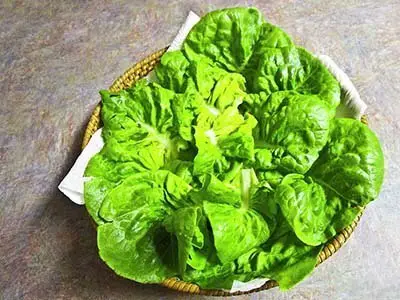Contents
It’s good to know that you can grow lettuce crops hydroponically with no real downsides. It’s the most straightforward vegetable to grow in a hydroponic garden.
Pick the Right Lettuce Type
Both the leaf lettuce and Bibb lettuce varieties grow rapidly. Likewise, Romaine also grows well, though it takes a little longer to mature. Below are some varieties that do well in hydroponics and under artificial lighting:
- Green Ice is a green loose-leaf variety with a long harvest season.
- Heat-tolerant and dark green, Royal Oak Leaf is an excellent type of lettuce for hydroponics.
- Red Fire is a deep red, loose-leaf type that grows well in both cool and warm climates.
- Tango prefers cooler temperatures to grow well.
 Growing Lettuce
Growing Lettuce
It would be best if you started lettuce plants in Rockwool starter plugs. You must soak Rockwool cubes in a pH-5.5 conditioning solution before planting. In this way, the pH of the plugs is lowered to about 6.2.
The excess solution is then drained off the Rockwool, and head lettuce seeds are inserted into each plug.
Place the tray of starter plugs near a window or under cool fluorescent light and cover with a plastic humidity dome. The lettuce seedlings will germinate in a few days.
When the roots begin to emerge through the plug’s bottom, you can transplant them into the hydroponic medium.
Growing Medium
Growing medium options for hydroponic systems include neutral pH media such as perlite, vermiculite, hydroton, gravel, sand, coco fiber, etc. We prefer:
Hydroton is the trademarked name for kiln-dried clay balls. The clay balls provide optimal root growth of hydroponic plants by retaining the right amount of air and water. Despite their higher cost, you can reuse these clay balls a great deal. Hydroton should be cleaned thoroughly before reusing. You should also soak the Hydroton pellets in water and hydrogen peroxide. Hydrogen peroxide is typically used at the rate of one tablespoon per gallon of water.
Growstones are another type of growing medium. Air and water content are balanced in such a way that they provide excellent success rates.
As a growing medium for vegetables and herbs, they hold three times more water and 12% more air than Hydroton type mediums. Made from up to 98% recycled glass bottles.
Coconut fiber: For hydroponic gardening, we recommend only the coarse, shredded coconut fibers, as they allow the water to flow downward. It is essential to rinse coco fiber very well before using it as it may contain high levels of sea salt.
Adding Nutrients
Hydroponic nutrients are essential! In hydroponics, all plants require the nutrients that soil cannot provide. Metal containers should not be used as a nutrient reservoir.
Ideal Conditions
Lettuce likes colder climates which means long days, and the hot summer sun can cause the plant to flower and acquire a bitter taste. Hence, it is essential to growing lettuce in a cool location.
You should regularly check the pH and the salt concentration of your nutrient solution. For hydroponic lettuce, a pH of around 6 is ideal. In terms of total salt ppm, we recommend keeping lettuce between 700 and 1000 ppm.
Indoor Lighting
The full spectrum light provided by metal halide lights is excellent for growing lettuce. A grow light plays a critical role in healthy lettuce growth rates as it contains essential phytonutrients.
Less expensive T5 fluorescent lighting is suitable for growing lettuce and need minimal initial investment. Lettuce grown indoors should be exposed to a minimum of 12 hours of light per day during the late fall and winter months. Prevent algae growth in the grow tank by minimizing direct sunlight.
Harvest & Storage
In general, hydroponically grown lettuce is harvested with its roots attached. When the roots are preserved, plants can be kept fresh for 2 to 4 weeks under the right conditions (near-freezing temperatures and high humidity). Pick the outer leaves as your head of lettuce grows, so you get an extended harvest of crisp, fresh lettuce. The inner leaves replace the mature leaves as soon as the outer leaves are cut away.

